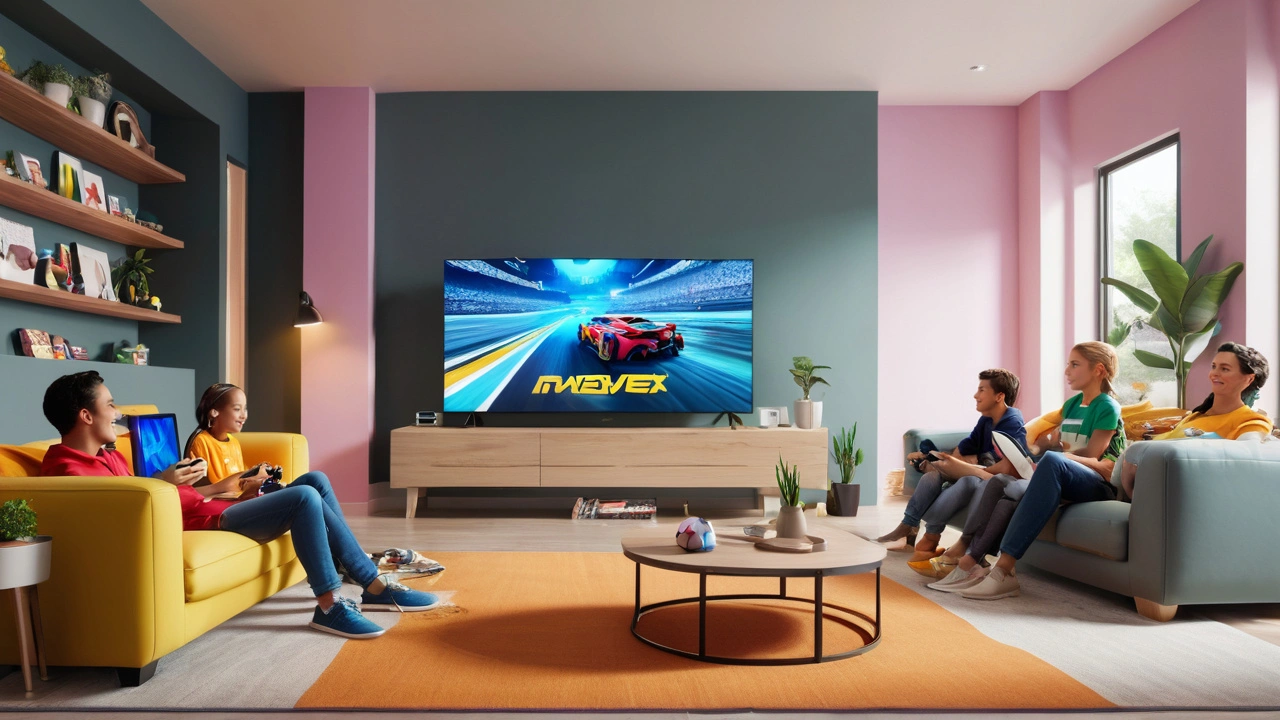Advertisers are always looking for new ways to capture the attention of potential customers. One of the latest trends taking the marketing world by storm is in-game advertising. This technique involves placing ads directly within the gameplay, creating a seamless experience for users.
There's something striking about seeing real-world brands in the virtual environments where people spend their time. It makes the experience more authentic and offers brands a way to reach an engaged audience. In-game ads are not limited to simple banner ads; they can be dynamic and interactive, offering gamers rewards or bonuses for interacting with the ads.
Imagine playing a racing game where your car drives past billboards featuring real-world products. Or consider a mobile game that rewards you with in-game currency for watching a short ad. These are examples of how in-game ads are becoming part of the fabric of games, blending seamlessly with the gameplay.
This trend not only benefits advertisers but also game developers. The revenue generated from ads enables developers to create better content and offer more free-to-play options for gamers. It creates a win-win situation where everyone can enjoy the benefits.
- The Rise of In-Game Advertising
- Benefits for Brands and Gamers
- Challenges and Considerations
- Future Prospects of In-Game Ads
The Rise of In-Game Advertising
The shift to in-game advertising marks a significant evolution in the marketing world. With the gaming industry booming, it was only a matter of time before advertisers saw the potential of this dynamic platform. Video games have moved beyond simple forms of entertainment to become complex, immersive experiences. This environment offers an unprecedented opportunity for brands to engage with their audience in meaningful ways.
Historically, advertising within video games began in the early 2000s, but it was rudimentary. Early attempts were limited to static billboards or background placements that didn’t interact with the player. Over time, as technology advanced, so did the methods of in-game advertising. Today, it’s not uncommon to find dynamic and interactive ads that adapt to the player's actions and decisions in real time.
From Console to Mobile
The advent of mobile gaming has particularly accelerated the rise of in-game ads. Mobile games are often free-to-play but monetize through advertisements and in-app purchases. This model has proven highly effective, drawing a massive audience that includes not just traditional gamers but casual players as well. According to a report in 2023, mobile gaming revenue reached over $90 billion, a large portion attributed to ad revenue.
Moreover, in-game advertising is seamlessly integrated into the gameplay. Instead of disrupting the player’s experience, ads are part of the game environment. Imagine playing a sports game and seeing a real-world brand advertised on the stadium walls. This type of placement feels natural and enhances the game’s realism. The same principle applies to mobile games where ad rewards can offer tangible benefits like extra lives or virtual currency.
Impactful Strategies
One successful strategy has been implementing reward-based ads. This approach involves granting players in-game rewards in exchange for watching an ad. It’s a win-win situation where the player gains something valuable, and the advertiser captures an engaged viewer. According to a study by Unity Technologies, rewarded video ads have an 87% completion rate, significantly higher than other ad formats.
Another impactful method is product placement. For instance, in racing games, players might drive by virtual billboards featuring real-life brands. Recently, popular franchises like FIFA and Fortnite have started collaborating with major brands to offer in-game skins and items themed around these collaborations. This maintains player engagement and creates a buzz around the brand.
“In-game advertising isn’t just about plastering a logo on a virtual wall,” says marketing strategist Jane Doe. “It’s about creating an immersive and interactive experience that resonates with players and adds value to their gameplay.”
All indications point to in-game advertising only growing from here. As virtual and augmented reality enter the mainstream, the lines between gaming and the real world will blur even further. This presents an exciting frontier for marketers who are looking to push boundaries and explore innovative ways to engage with consumers.
For brands willing to dive into this space, the potential rewards are substantial. The key lies in creating ads that resonate with the gaming audience—an audience that is tech-savvy, young, and engaged. By integrating advertisements that enhance rather than interrupt the gaming experience, brands can build genuine connections and brand loyalty.

Benefits for Brands and Gamers
In-game advertising is more than just a passing fad; it has solidified itself as a robust marketing channel with a multitude of benefits for both brands and gamers. Firstly, brands can tap into a highly engaged audience. Gamers often spend hours immersed in their favorite titles, leading to greater exposure and brand recall. This level of engagement is hard to achieve with traditional ads. Additionally, in-game ads are a great way to target the younger demographic, who are increasingly spending more time playing games.
The interactive nature of video games offers a unique platform for brands to create memorable, immersive experiences. Instead of just placing a banner ad, brands can craft entire segments of the game that reflect their identity. For instance, integrating a brand's product into the storyline or designing a special level around the brand creates a seamless experience. A great example of this is when 'Fortnite' partnered with Marvel Studios to feature 'Avengers: Endgame' elements, making the promotion feel like a natural part of the game.
Another significant benefit is the ability to collect vast amounts of data for more precise targeting. In-game ads can track user behavior, preferences, and interaction, helping brands to better understand their audience. This data is invaluable for refining marketing strategies and creating personalized campaigns. The effectiveness of ads can be measured in real-time, enabling quick adjustments and optimizations.
According to a study by Newzoo, "Worldwide game revenues will exceed $175 billion by 2024," reflecting the massive potential for brands willing to invest in this space.
For gamers, in-game ads can enhance the gaming experience when done correctly. Ads that offer in-game rewards, such as bonus levels, special items, or virtual currency, can make the gameplay more exciting and rewarding. Players might watch a short ad to earn extra lives or complete an in-game challenge sponsored by a brand for some in-game perks. This approach creates a positive association with the brand as it adds value to the gaming experience.
Game developers also stand to benefit significantly. The revenue from ads can support the development of new content and updates, ensuring that games remain fresh and engaging. This financial boost is particularly crucial for indie developers who might lack the resources of larger studios. By integrating ads that fit naturally within the game’s environment, developers can generate revenue without disrupting the player experience.
Moreover, in-game ads can lead to more free-to-play models, making games accessible to a broader audience. This democratization of gaming means more people can enjoy high-quality games without an upfront cost. As a result, the player base expands, offering even more value to advertisers.
In summary, in-game advertising presents a host of benefits for brands, gamers, and developers. It is rapidly becoming a vital component of digital marketing strategies, providing immersive, data-driven, and engaging ways to connect with audiences. The future looks promising as technology continues to evolve, offering new avenues for creativity and engagement in the gaming world.

Challenges and Considerations
While the concept of in-game advertising offers significant promise, it doesn't come without its challenges. One major concern is the potential to disrupt the gaming experience. Gamers are highly protective of their experience, and any ads perceived as intrusive can lead to player dissatisfaction. The balance between engaging advertisements and intrusive experiences is delicate, and getting it wrong can lead to negative feedback.
Privacy is a pressing issue on the digital marketing agenda. With in-game ads, there arises the question of how much data should be collected about players. While ads can be highly targeted to enhance relevance, they must also respect privacy laws and regulations. Call it the Cambridge Analytica effect—it’s made users more aware and concerned about how their data is used. Game publishers need to adhere to data protection regulations like GDPR and CCPA, ensuring they are transparent about data collection practices.
Sourcing and integrating ads that fit seamlessly into the gaming environment can be another challenge. The ads must not only look like they belong in the game setting but also offer an engaging experience for players. This requires a creative approach from both advertisers and game developers. It’s not just about slapping a billboard in a racing game; it’s about making that ad feel like a natural part of the game world.
Technical constraints can pose significant issues. Games require a consistent performance level, and poorly integrated ads can lead to bugs or performance dips. Agencies and developers must work together to optimize ad implementation. This can mean additional development time and resources, which isn’t always feasible or desirable for fast-moving tech companies.
Financial considerations also play a role. While large game studios might have the resources for sophisticated ad integration, smaller indie developers might struggle. Often, the revenue share models might not be attractive enough, making it an unfeasible option for some. This could create an uneven playing field where only the big players benefit from in-game advertising, leaving smaller studios in the lurch.
Ad intensity and frequency is another issue to ponder. Too many ads within a short gameplay session can lead to player fatigue. It’s crucial to monitor ad frequency and ensure players aren’t bombarded. A responsible approach to ad frequency can keep the user experience enjoyable while still monetizing effectively.
You might also face the barrier of gamer demographics. Video game audiences are diverse, and not all segments are equally receptive to advertisements. Younger players may be more ad-tolerant, but older gamers might find them annoying. Knowing your audience and tailoring ads to fit their preferences is key.
"Strategic ad placement and respecting the gaming experience is crucial. Players need to feel engaged, not invaded," says Jane Smith, a marketing strategist with Gaming Insights.
The quest for balance is ongoing. Striking the right balance between monetization and player experience requires continuous adjustment and player feedback. Game developers and advertisers need to stay vigilant and adapt strategies based on what gamers are saying.

Future Prospects of In-Game Ads
In-game advertising is poised to become a major force in the marketing world. As technology evolves, so does the potential for more sophisticated and immersive ads. One of the most exciting developments is the use of augmented reality (AR) and virtual reality (VR). These technologies allow for an advertising experience that feels incredibly real and engaging. Imagine walking through a virtual mall, trying on clothes from your favorite brands before purchasing them in the real world. This level of interactivity can create a deeper connection between the consumer and the brand.
Another promising area is the rise of personalized advertising. With advancements in artificial intelligence, brands can tailor their ads to individual players based on their behavior and preferences. This means that two players in the same game might see entirely different ads, each perfectly suited to their tastes. This level of customization can significantly increase the effectiveness of the advertising, making it more likely that players will engage with the ads.
Interestingly, the data generated from in-game interactions can also provide valuable insights for marketers. They can track what types of ads draw the most attention, how players interact with them, and even measure the impact on brand recall and purchase decisions. According to a eMarketer report, the spending on in-game ads in the U.S. alone is expected to reach $3 billion by 2025, illustrating the growing importance of this medium.
The ethical considerations around in-game advertising can't be ignored. There is a fine line between enhancing the gaming experience and disrupting it. Brands need to ensure that ads are integrated in a way that feels natural rather than intrusive. This means working closely with game developers to create ads that match the aesthetic and vibe of the game.
"In-game advertising has the potential to revolutionize the way we think about marketing," said Jane Smith, a leading digital marketing strategist. "It's all about creating a seamless experience that adds value for the player, rather than taking away from it."In addition, with the growth of esports and streaming platforms like Twitch, there are even more opportunities for in-game advertisements. Brands can sponsor events, teams, or individual players, reaching millions of viewers worldwide. These sponsorships can be more engaging than traditional ads since they often involve the influencers that gamers trust and admire.
One of the key challenges moving forward will be maintaining the trust of the gaming community. Gamers are savvy and can quickly recognize when they're being marketed to. If they feel that ads are taking away from their experience, they may push back. Brands that can strike the right balance will be best positioned to thrive in this new landscape.
Looking ahead, the potential for cross-platform advertising is immense. As games become more integrated across devices, from mobile phones to consoles, there is an opportunity for a cohesive advertising strategy that follows the player across their entire gaming journey. This could include everything from ads within the game itself to promotions on social media and streaming sites connected to the game.




Write a comment